1lumen selects and reviews products personally. We may earn affiliate commissions through our links, which help support our testing.
Acebeam & Maratac Defender P16 review
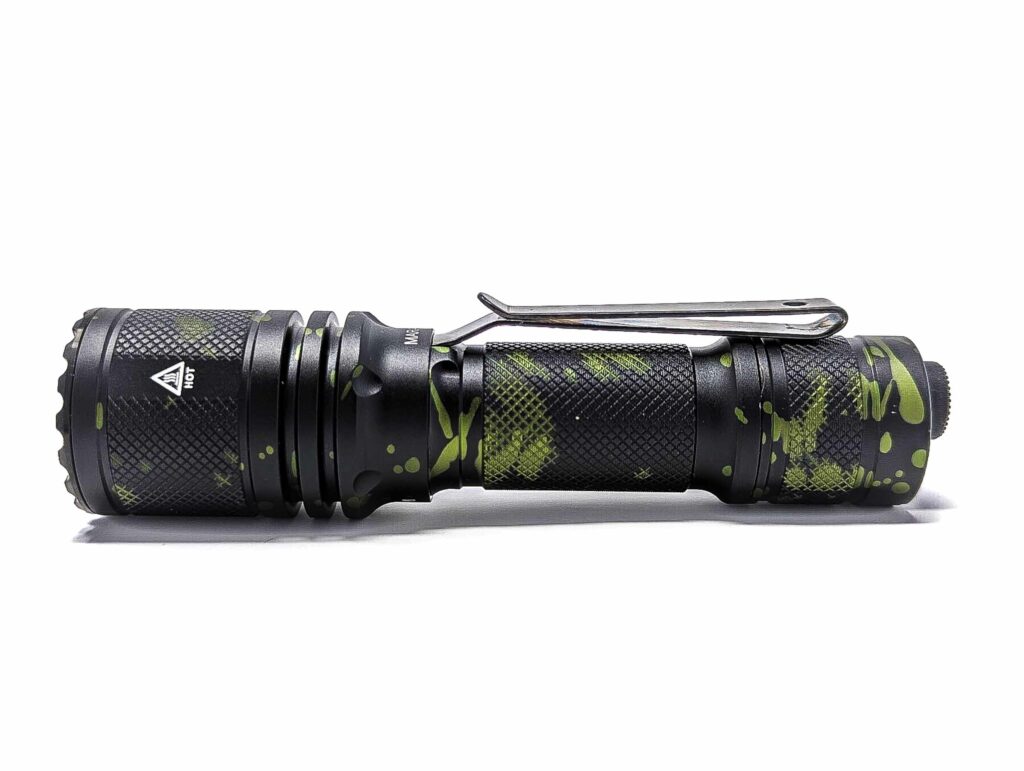
Maratac Defender P16 specs
| Brand & Model | Acebeam & Maratac Defender P16 |
|---|---|
| Flashlight category | Tactical, EDC |
| LED | Luminus SFT40 |
| Max. output | 1800 lumens |
| Max. beam distance | 484 meters |
| Max. beam intensity | 58,564 cd |
| Battery config. | 1x 18650 or 2x CR123 |
| Onboard charging | No |
| Main modes | 4 |
| Blinkies | Strobe, SOS |
| Waterproof | IP68 |
| Review publication date | November 2023 |
Review intro:
Let’s be honest, there are an awful lot of flashlight brands. Some of them get a lot of attention on enthusiast forums like BudgetLightForum and Reddit’s r/flashlight, some don’t. We see a lot of less-expensive options (Sofirn, Wurkkos, Astrolux, etc) and plenty that are just great values, even if they’re a little more expensive. When it comes down to it, though, you usually get what you pay for. Don’t get me wrong – I love budget lights and have a ton of them; but usually corners have been cut, especially in terms of driver quality (cheap FETs vs buck/boost). This is where my appreciation for some of the more expensive brands comes in. Brands like Acebeam tend to put out high-quality lights with good drivers that help maximize efficiency and runtime. The recent Acebeam E75 is a good example of that – not cheap, but a truly amazing flashlight.
On the review menu for today is another entry by Acebeam. However, this is a special collaboration light with CountyComm to commemorate their 33 anniversary. To celebrate, they created a co-branded Acebeam/Maratac OD Green Splash version of the Acebeam Defender P16. This serialized flashlight is a limited edition with only 1000 pieces available. This tactical/daily flashlight is built around a 18650 battery, uses dual tail switches for control, and features a pretty nice TIR.
To get up and running with the Defender P16, just pop in a battery, remove the protection film from the TIR, and you’re off to the races!
Package quality.
When I received my first couple of Maratac flashlights, I was a bit shocked at their packaging. Everything was tightly crammed into a little, clear, plastic square tube. I wasn’t sure if it was just those models, but this is my fourth flashlight that has arrived in the same manner. So apparently that’s just Maratac’s thing. In the clear plastic tube was:
- Acebeam/Maratac Defender P16
- Lanyard
- Spare O-rings
- Manual
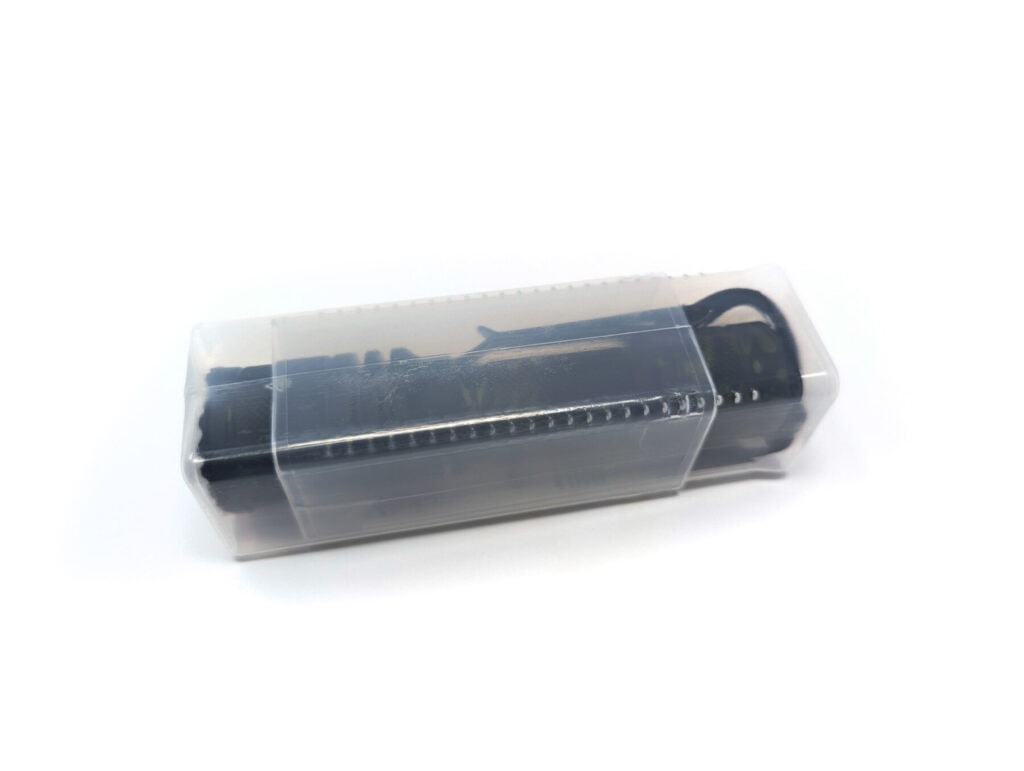
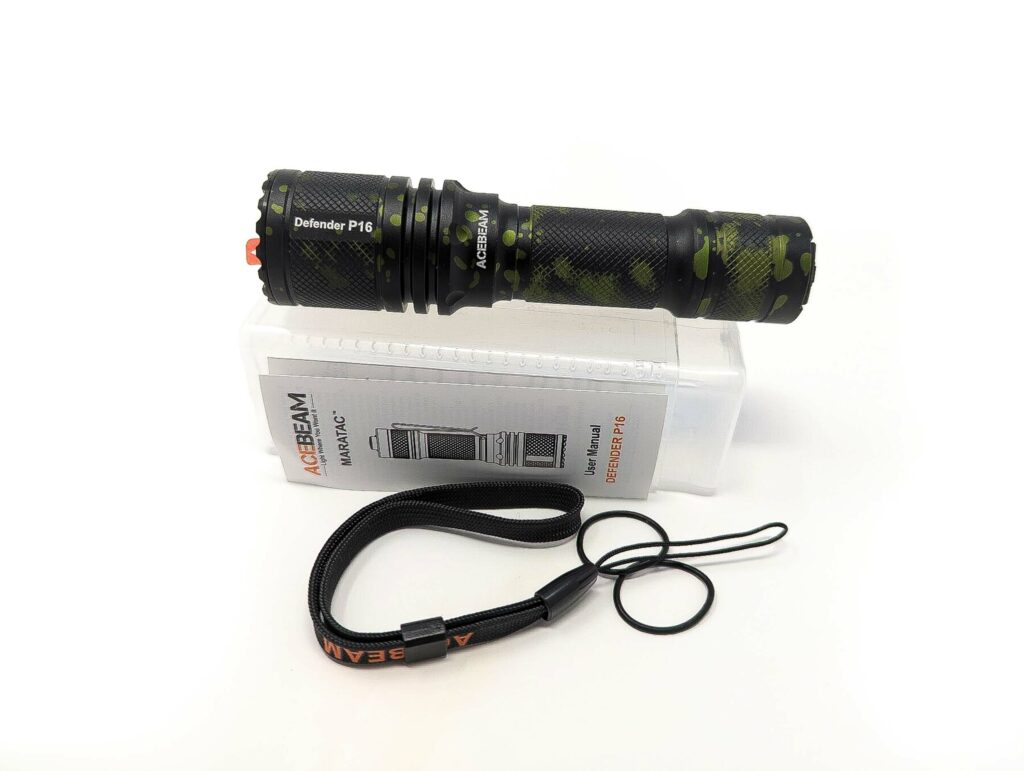
Flashlight in use, Build Quality, and Warranty
The Acebeam/Maratac Defender P16 utilizes an 18650 battery, so it’s a bit on the smaller side, but not too much so. It’s a very comfortable size to walk around with, in your hand and stow in a jacket pocket. The P16 comes with a large 2-way clip preinstalled. The pocket clip is actually mounted to the battery tube underneath its connection to the head, a secure design with no movement of the clip. So you could remove the clip by unscrewing the head and then popping it off if you wanted to.
The dual switches are located on the tailcap, as is fairly common with tactical-ish flashlights. The most prominent button is a forward-clicky switch that is used for on-off (and momentary) purposes. The second is an e-switch that is situated toward the rim of the tailcap; it provides mode-switching and shortcut capabilities.
Anti-roll protection is provided by the pocket clip. The protruding tail switches rules out any possibility of tail-standing. The only attachment point that I see for the provided lanyard is a hole in the tail end of the pocket clip – perhaps not ideal, but it works.
When it comes to build quality, I have yet to be disappointed by anything built by Acebeam or sold by CountyComm (Maratac is the house brand of flashlights by the CountyComm company). The P16’s body is built from the usual “aircraft-grade” aluminum and boasts a Type III hard anodizing. I would call the finish to be nice and matte without being chalky. The OD Green Splash is a break from the typical black or grey finish and is pretty neat looking.
The Defender P16 has two UIs, the choice of which would be influenced by how you intend to use the flashlight. If you want the light for tactical-ish duties, the Tactical Mode provides one-touch strobe access which could be good if you’re concerned with encountering an attacker (strobe is better than nothing, I suppose). The Daily Mode swaps that shortcut for one-touch Low mode, which is a nice offering. In general, this would make a good around-the-house kind of light with its long-running dependable output. It would be right at home in the woods, camping, hiking, or for general outdoor activities with its throwy beam. However, with the lowest mode coming in around 50 lumens and it having a pretty tight beam, I would reach for other flashlights for general “inside the house” tasks.
Warranty coverage: “Full 365-day warranty on all items we sell from defect or failure. We stand behind every product we sell 100% from watches to flashlights, we have you covered!”
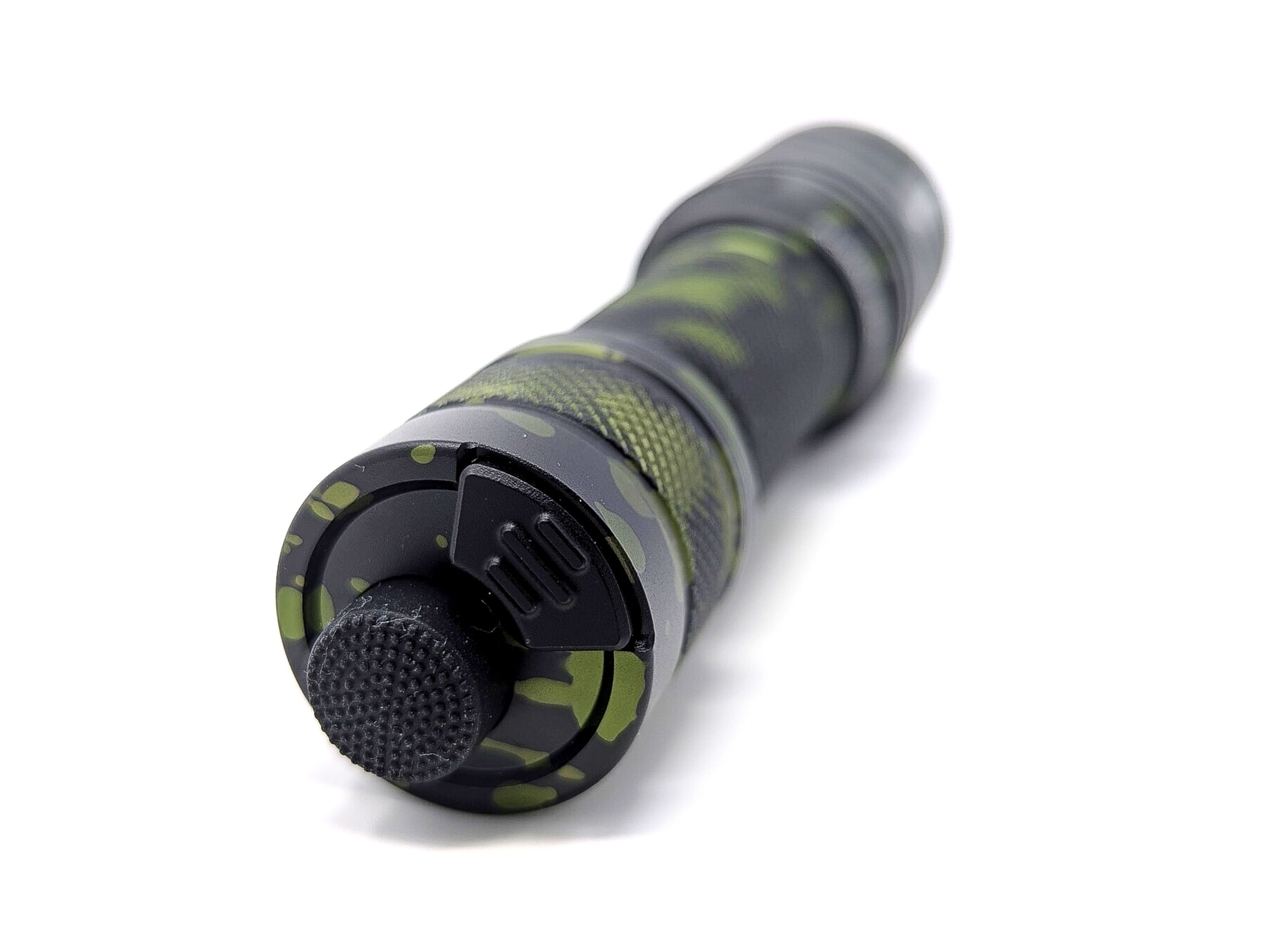
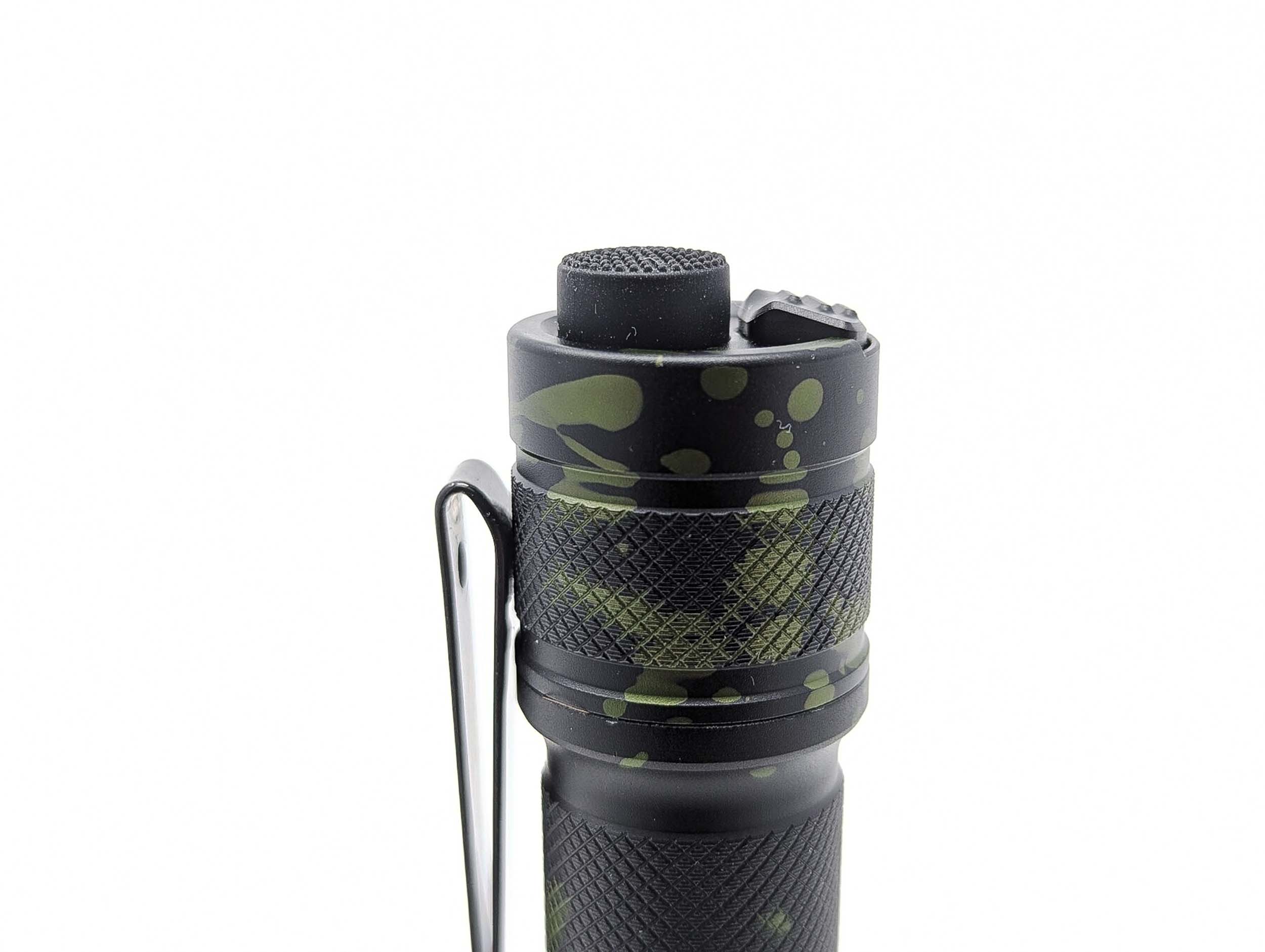
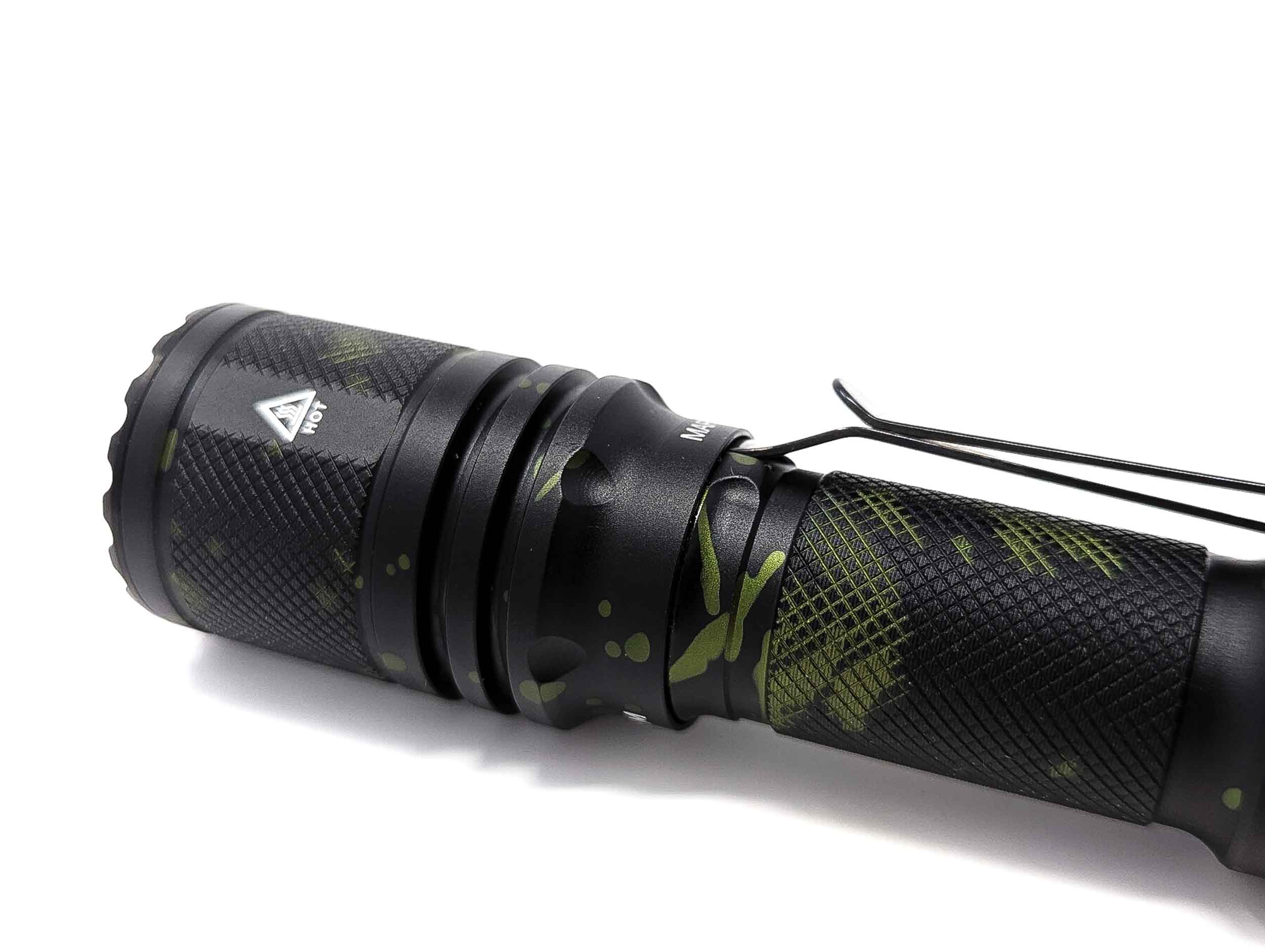
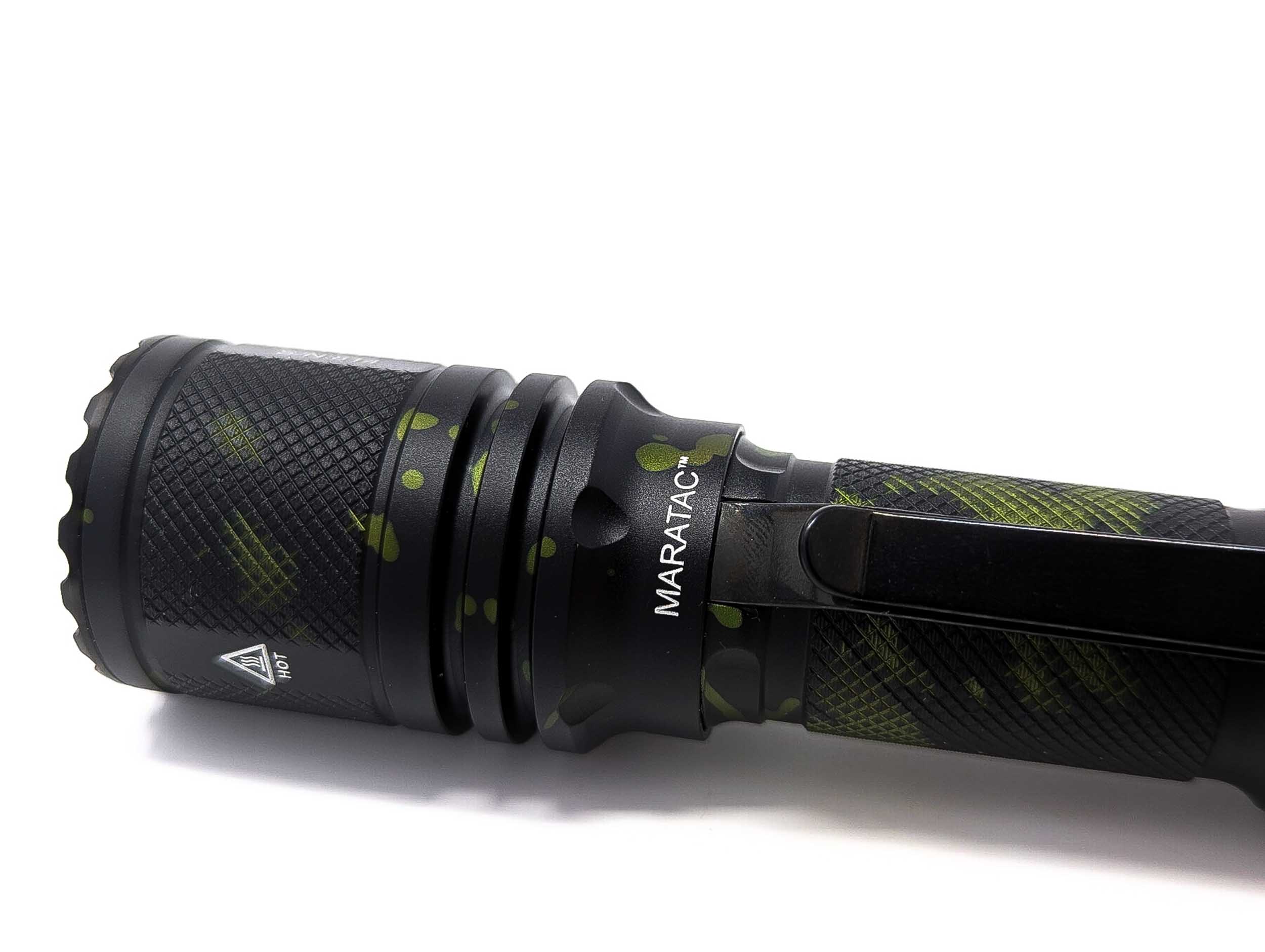
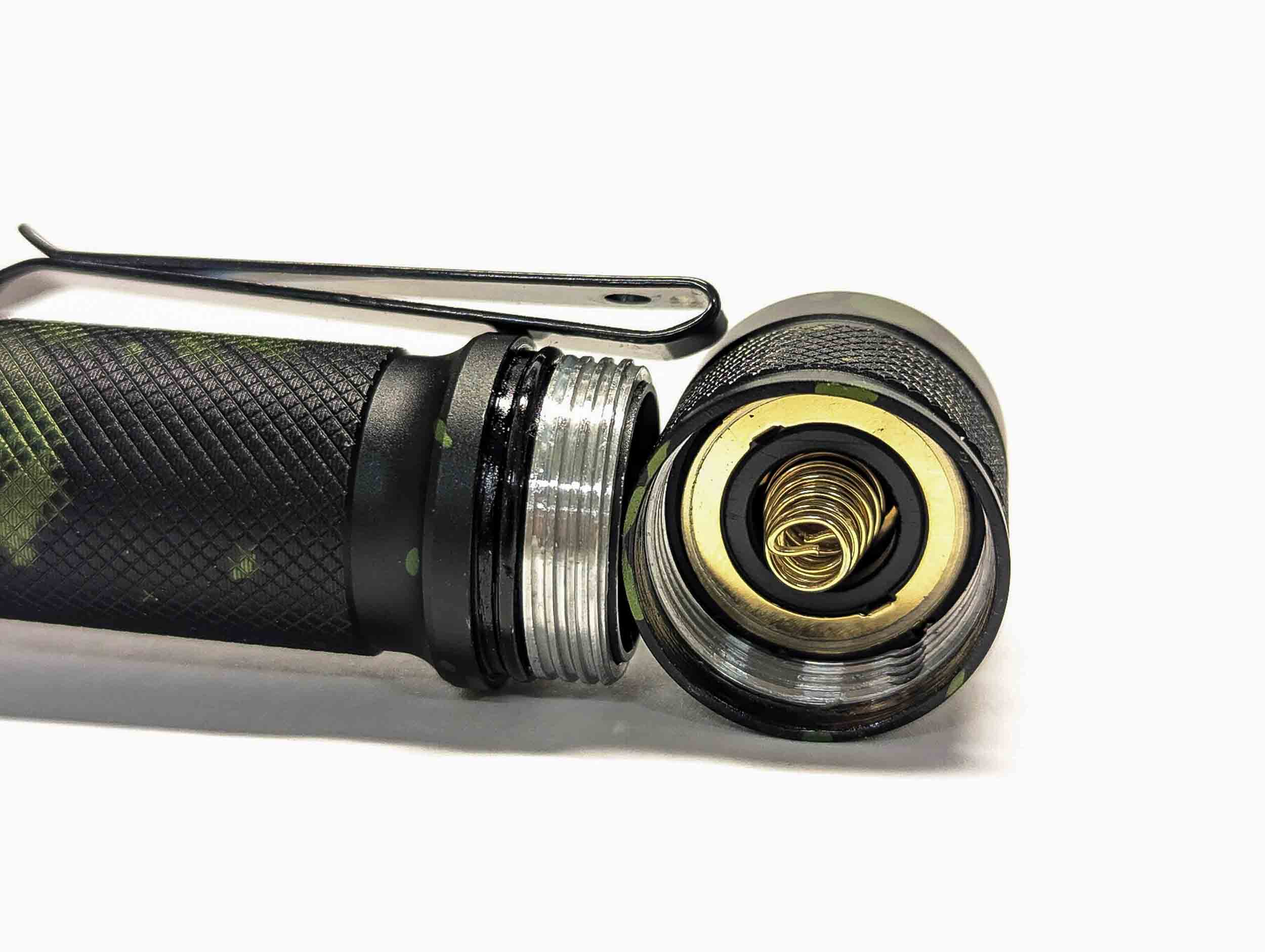


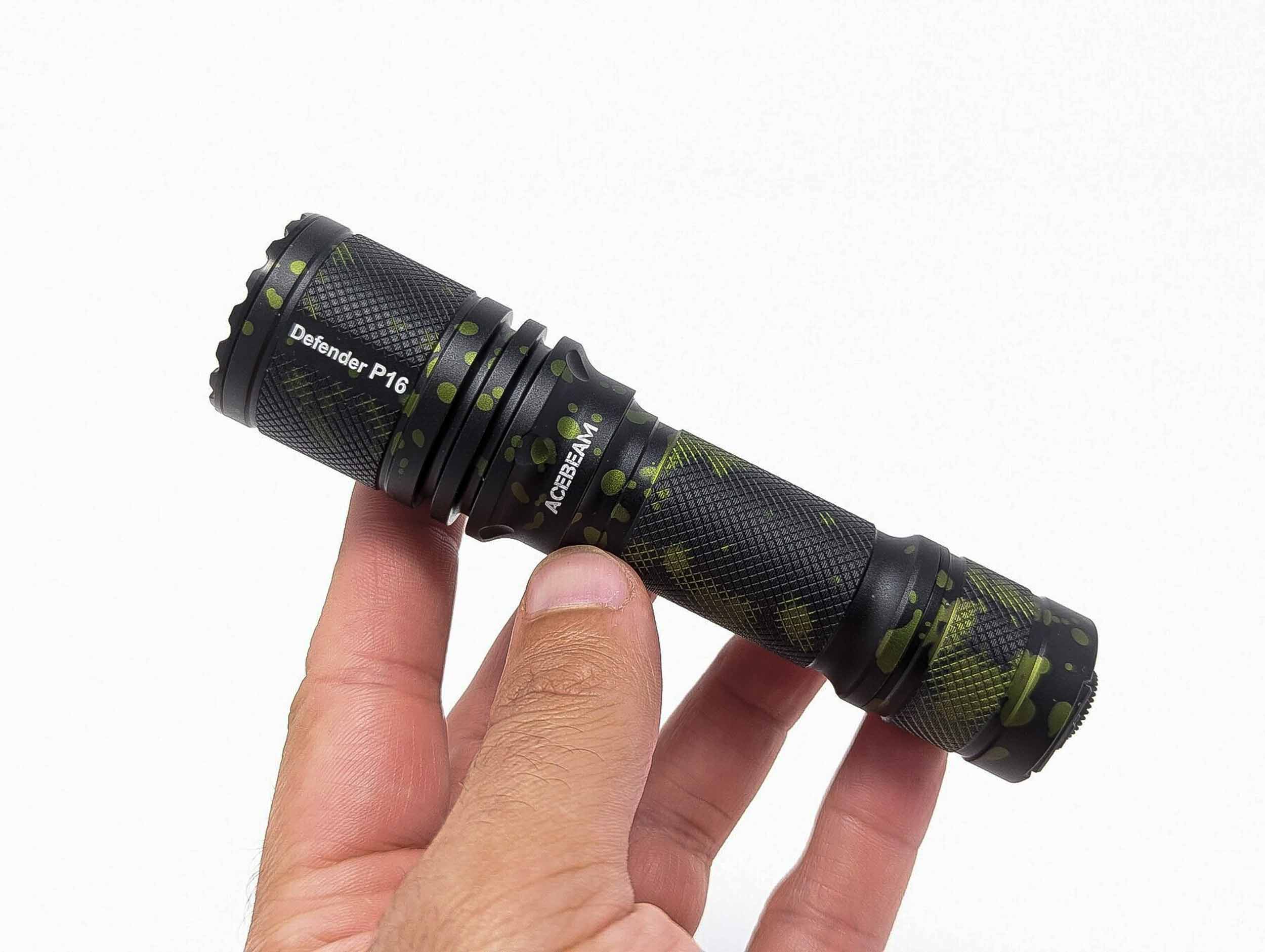

LED, Lens, Bezel, Beam, and Reflector
The business end of the Defender P16 is protected by a blacked-out stainless steel bezel ring. It’s crenulated; not terribly sharp, but could probably do some damage to pants pockets after extended use. Maratac says that this “strike bezel” can also be used as a glass breaker in an emergency.
Situated under the bezel is a nice TIR lens that is protected by a sheet of anti-reflective glass. The TIR sits atop a Luminus SFT40 LED, a domeless, high-output emitter. While this is a 70-CRI cool-white offering, as almost all SFT40 LEDs are, you can occasionally find 3000K 95-CRI SFT40’s around. Perhaps I’ll mod my P16 with one of these emitters, but I digress…. The domeless SFT40 LED and narrow TIR lens produces a very concentrated beam with a clean, small hotspot and wide, faint spill. The beam is overall very throwy for this size of flashlight.
Spectral measurements:
I used an Opple Light Master to measure the flashlight at 5 meters distance.
| Mode: | CCT: | CRI Ra: | duv |
|---|---|---|---|
| Turbo | 6165 K | 68.7 | +0.0022 |
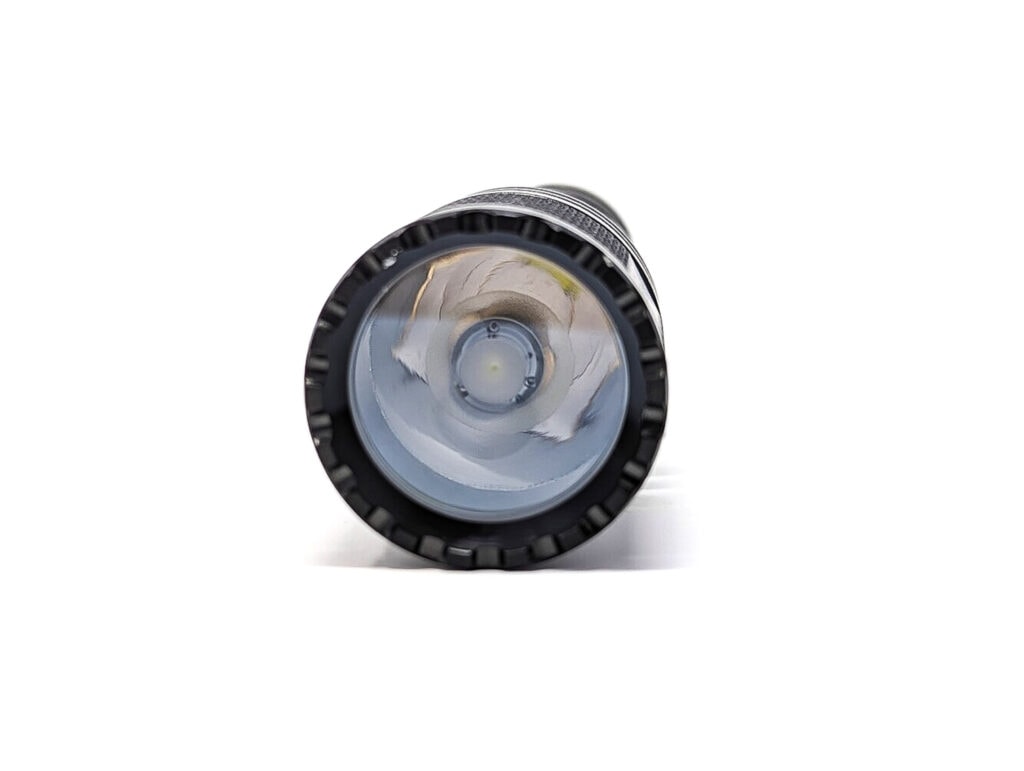


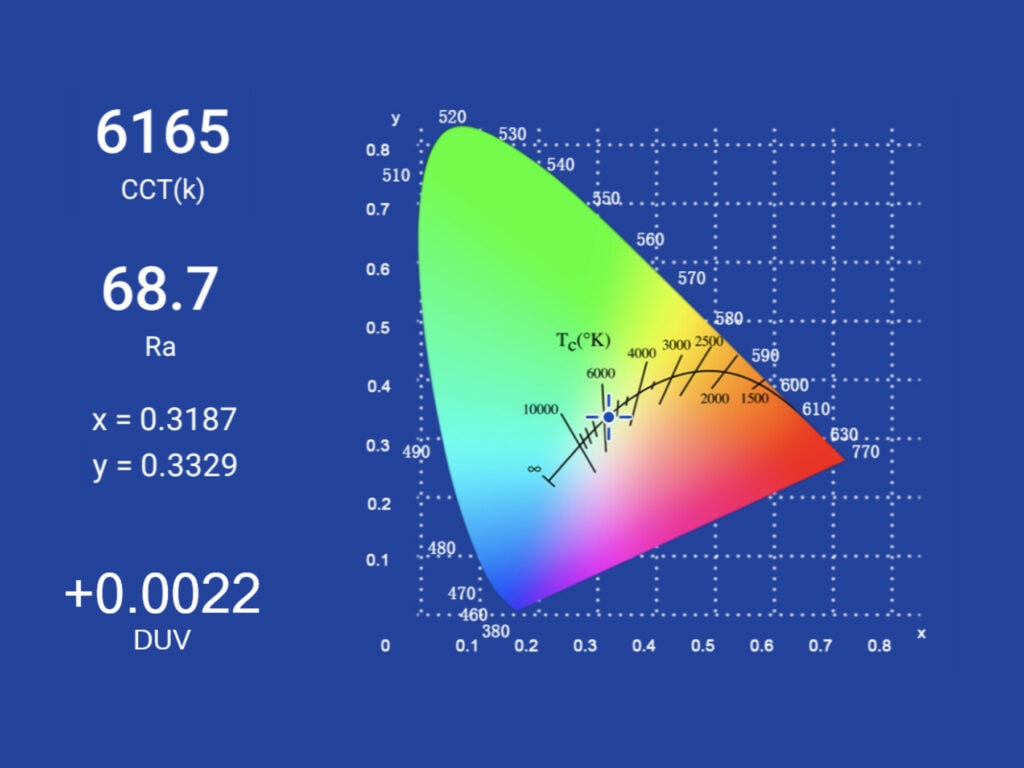
Dimensions and its competition
Dimensions:
| Millimeters | Inches | |
|---|---|---|
| Length | 131 mm | 5.2 in |
| Head diameter | 32 mm | 1.3 in |
| Body diameter | 23 mm | 0.9 in |
Weight:
| Weight in grams | Weight in oz | |
|---|---|---|
| Without battery: | 110 g | 3.9 oz |
| With battery (Samsung 30Q) | 155 g | 5.5 oz |
Flashlight size comparison with its competition:
Group 1: Maratac Tri-Flood Pro, Acebeam/Maratac Defender P16, Maratac Mini LEP Cosmos
Group 2: Olight Baton 3 Pro Max, Acebeam/Maratac Defender P16, Nitecore P20iX
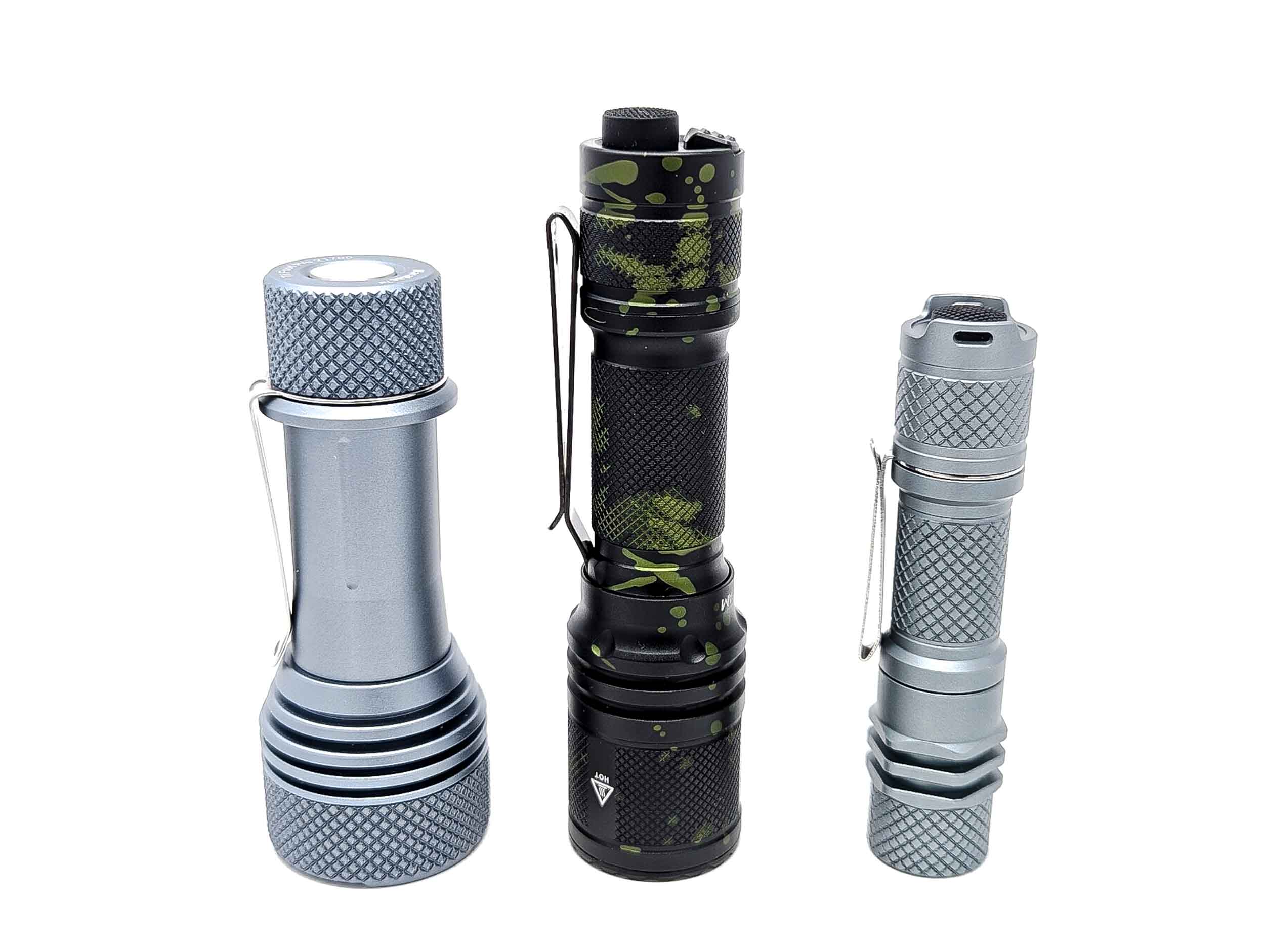
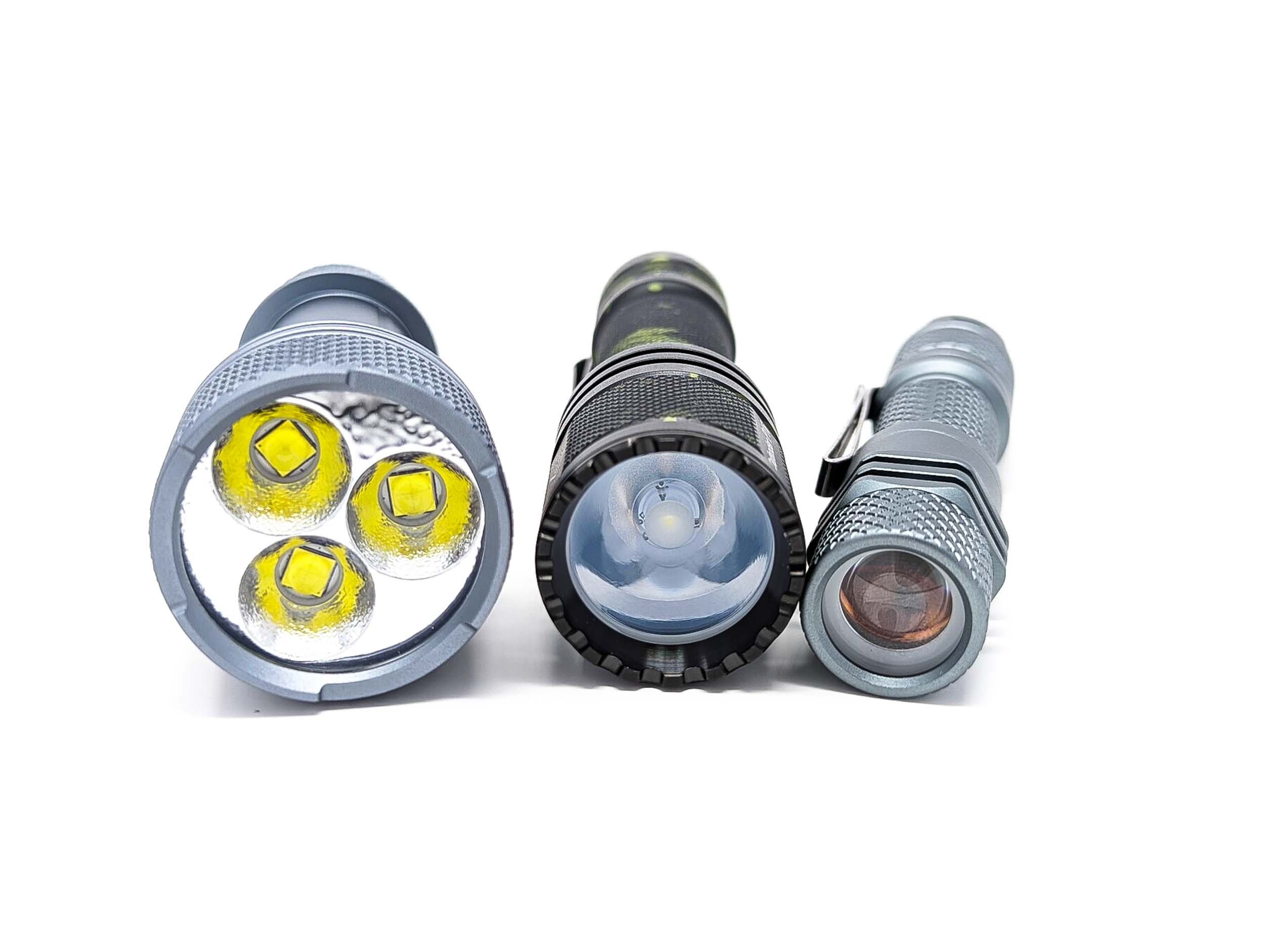

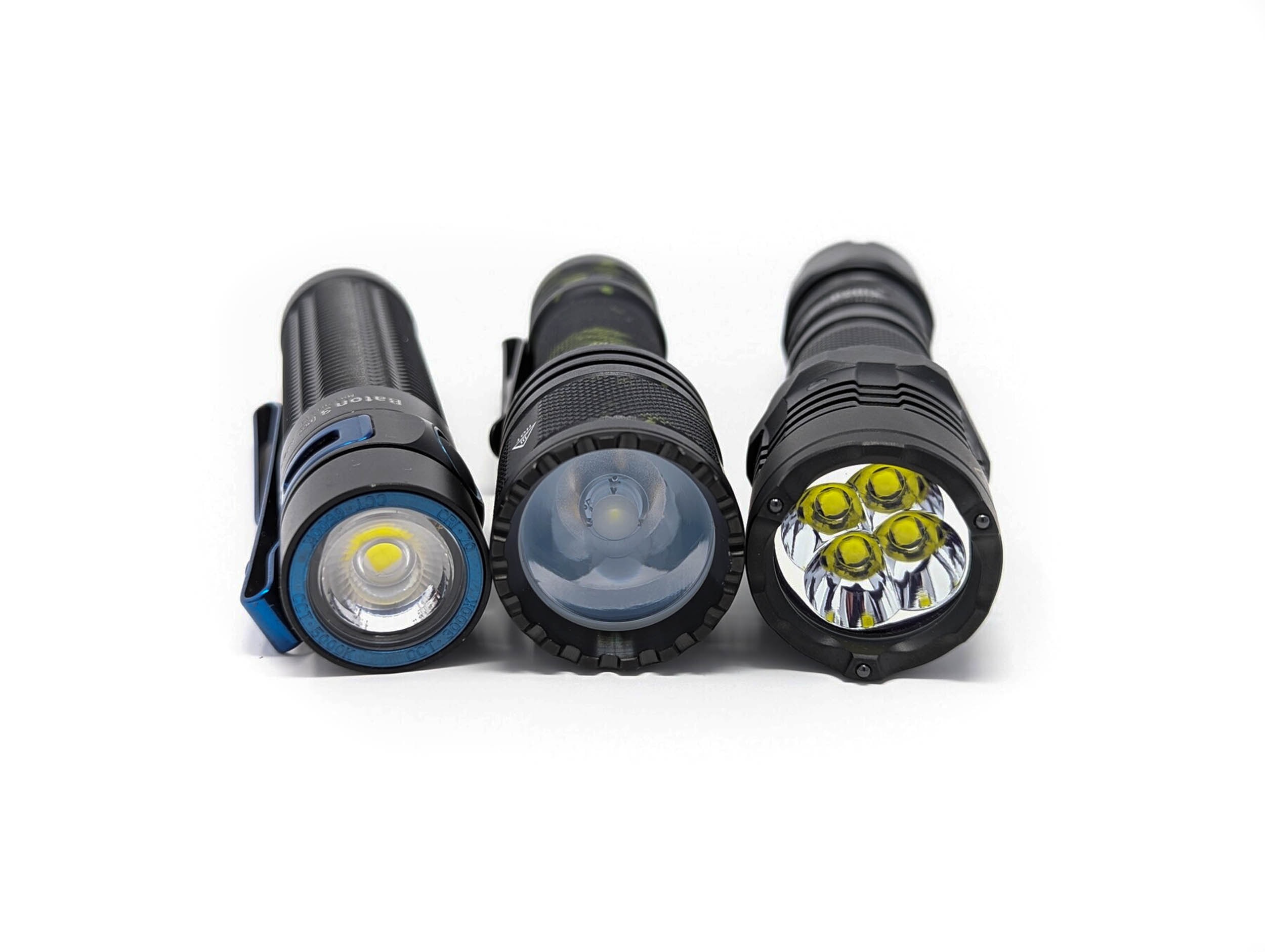
Maratac Defender P16 UI: User Interface and Driver
The Acebeam/Maratac Defender P16 uses a constant-current buck driver for excellent output regulation. The dual tail-switch design pushes the P16 towards the “tactical” realm, but it actually offers two (slightly) different UI modes that you, the user, can switch between: Tactical Mode and Daily Mode.
When talking about the UI, the forward-clicky switch is referred to as the Tactical Switch. The e-switch is called the Functional Switch.
Available modes:
- Low, Med, High, Turbo
Available blinky modes:
- Strobe, SOS
Tactical Mode
From OFF:
- Tactical Switch, press and hold: momentary on
- Tactical Switch, click: on
- Functional Switch, press and hold <3 seconds: momentary strobe
- Functional Switch, press and hold >3 seconds: strobe
From ON:
- Tactical Switch, click: off
- Functional Switch, single click: change brightness
- Functional Switch, press and hold >1 second: strobe
Daily Mode
From OFF:
- Tactical Switch, press and hold: momentary on
- Tactical Switch, click: on
- Functional Switch, press and hold <3 seconds: momentary low
- Functional Switch, press and hold >3 seconds: low
From ON:
- Tactical Switch, click: off
- Functional Switch, single click: change brightness
- Functional Switch, press and hold >1 second: SOS
Mode memory:
- Daily Mode: the manual explicitly states that it uses mode memory (which is correct)
- Tactical Mode:
- The manual doesn’t call out mode memory for Tactical Mode, whereas it does for Daily Mode, which leads to believe that it shouldn’t have mode memory
- CountyComm’s website explicitly states “one-touch strobe, turbo and low activation”, which further makes me believe that Tactical should default to Turbo mode, as there is no other action in the UI depiction that would lead to one-touch turbo.
- Acebeam’s own website uses the same “one-touch strobe, turbo and low activation” language to describe the UI.
- Despite all of this, I don’t see any way to do one-touch turbo. Tactical Mode appears to have mode memory, just like Daily Mode does. To me, this seems like a UI oversight/goof-up.
Shortcuts:
- To Low: in Daily Mode, press (or press and hold) the Functional Switch
- To Turbo: missing
- To Strobe: in Tactical Mode, press (or press and hold) the Functional Switch
Low voltage warning/protection:
- The output will step down as the battery power gets low, and will eventually shut off
- I don’t see it mentioned in the manual, but the light also blinks every 30 seconds after it steps down to the lowest mode
Strobe/blinkies
- Strobe: accessed in the Tactical Mode by pressing (or holding) the Functional Switch
- SOS: accessed in the Tactical Mode by pressing and holding the Functional Switch for >1 second while on
Lock-out mode:
- CountyComm’s website mentions a lockout mode without saying how to activate it. There is no mention of a lockout mode in the manual. I don’t see any way to electronically lock out the P16. You can slightly unscrew the tailcap for physical lockout.
PWM
- There is no PWM
Additional/summary info on the UI:
- To switch between Tactical and Daily modes, turn the flashlight off. Press and hold the functional switch for 3 seconds. While continuing to hold down the Functional Switch, click the Tactical Switch. The main LED will begin “breathing”. At this point, release the Functional Switch and then click it. The light will then enter Strobe mode to indicate that it is now in Tactical Mode, or SOS to indicate that it is in Daily Mode. Click the Tactical Switch to exit.
- With how the UI stands, the main difference between Tactical and Daily Modes is that Tactical provides one-touch strobe while Daily provides one-touch low.
- I feel that the apparent missing one-touch strobe feature that is advertised is a big oversight, and one that detracts from this being an appropriate “tactical” flashlight.
Maratac Defender P16 Charging and batteries
If you were to buy the Defender P16 from Acebeam, you would receive an included USB-C rechargeable 18650 battery. But with buying this special commemorative edition from CountyComm, you’ll either need to add one to your CountyComm shopping cart or provide one of your own. There are springs at each end, so the Defender P16 should be pretty forgiving in terms of overall battery length compatibility. In my testing, I used a flat-top Samsung 30Q that I had on hand.
| Charge type | Fits | No fit | Charge time |
|---|---|---|---|
| N/A | All (?) 18650 batteries | – | N/A |
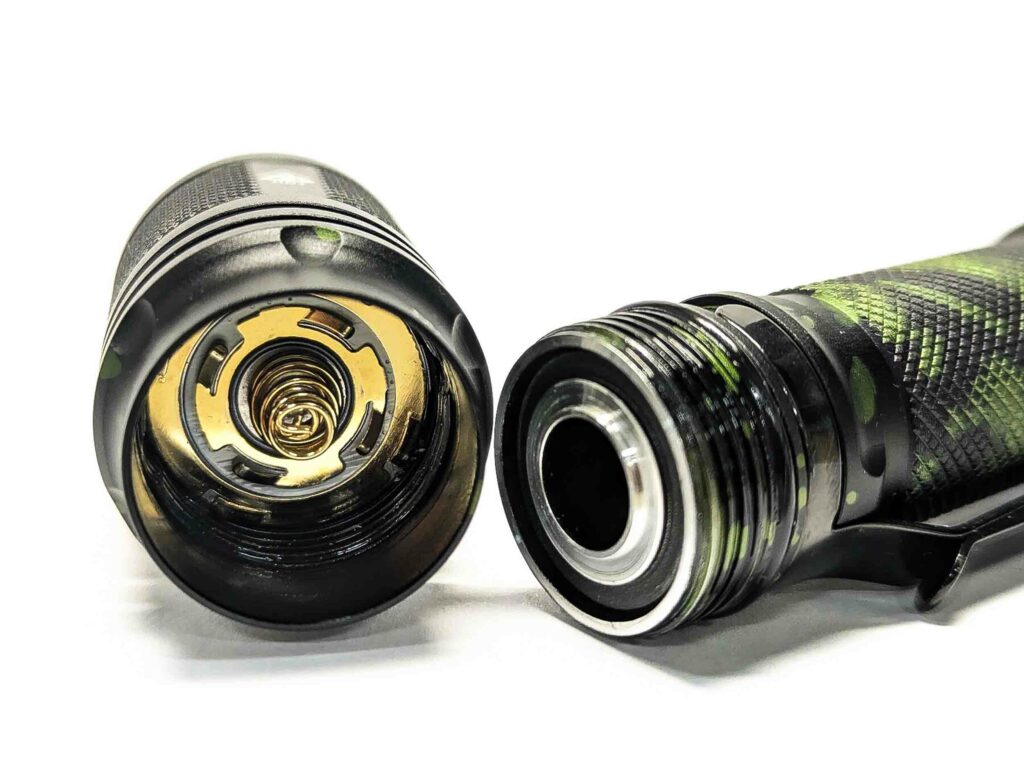
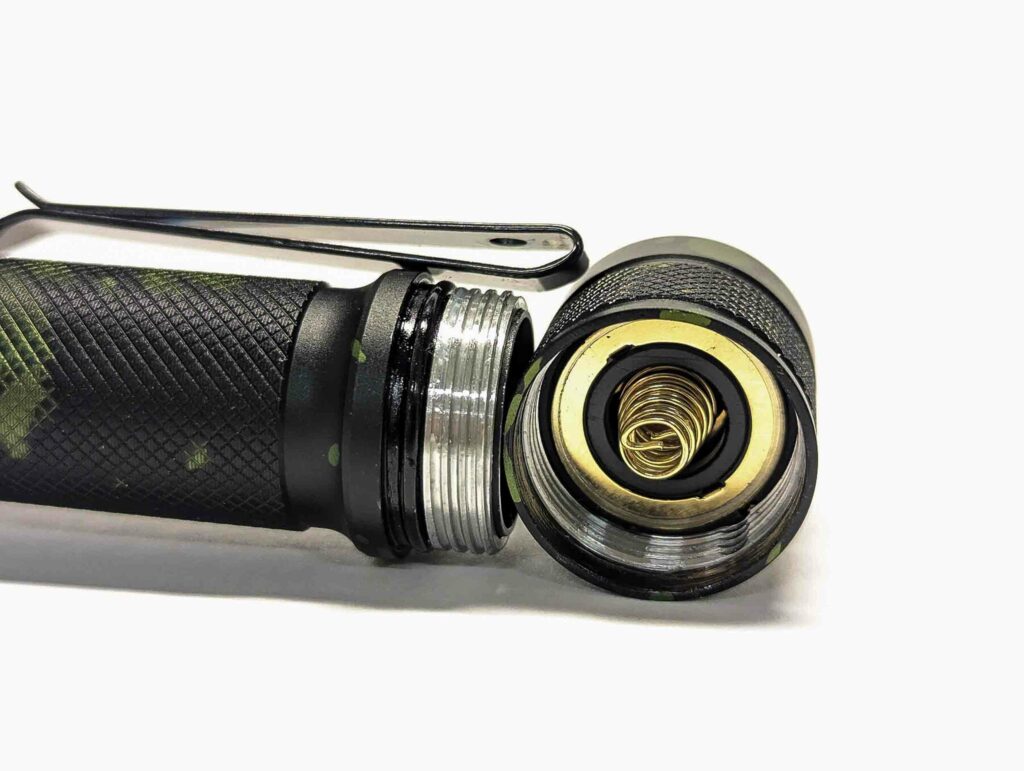
Performance test
Lumen measurements
How Lumens are Measured: Understanding ANSI FL1 Standards How Lumens are Measured: Understanding ANSI FL1 Standards: The ANSI FL1 standards specify that output in lumens should be measured 30 seconds after turning on, as this is the standardized time for measuring brightness according to the industry standard. This is why we focus on this part in our measurements. The ANSI FL1 standards require an ambient temperature of 22 ± 3°C. We record the ambient the ambient temperature to identify potential reasons for any observed discrepancies.Lux was measured by a UNI-T UT383 BT at 5 meters. Lumens were measured in a homemade lumen tube using a VEML7700 sensor, calibrated with a calibration light provided by 1Lumen. A Samsung 30Q battery was used for testing.
| Mode | Specified | 0 sec. | 30 sec. | 10 min. |
|---|---|---|---|---|
| Low | 50 lm | 37 lm | 37 lm | |
| Med | 260 lm | 244 lm | 244 lm | 241 lm |
| High | 900 lm | 861 lm | 853 lm | 665 lm |
| Turbo | 1800 lm | 1,633 lm | 1,532 lm | 661 lm |
| Turbo at 3.6V* | – | 1,230 lm | 1,154 lm | 236 lm |
Parasitic drain:
- N/A – couldn’t measure due to dual-tube design
As with the past few Maratac flashlights that I’ve reviewed, this one just doesn’t hit the claimed output in my testing. On one hand, I’m not all that surprised. On the other hand, this is essentially an Acebeam P16 with a special exterior finish – so it should perform up to Acebeam levels, which I think more highly of. To be fair, my Samsung 30Q is several years old and could possibly not hit quite as hard as it used to. While I was not able to hit the claimed output, I’m not using the same battery that Acebeam used in their testing to get their specs. The output on Turbo very likely is highly dependent on your choice of battery. Even though this is a buck driver, I wouldn’t doubt that those ~2 minutes of Turbo are unregulated, and then it drops down to regulated output.
Maratac Defender P16 Battery Life: Runtime graphs
How Runtimes are Measured: Understanding ANSI FL1 Standards About ANSI FL1 runtime standards: The runtime is measured until the light drops to 10% of its initial output (30 seconds after turning on). This does not mean that the flashlight is not usable anymore. The last column shows how long the light actually works till it shuts off. If there is a + symbol, it means that the test was stopped at that particular point, but the light was actually still running. This happens on certain occasions, with certain drivers, firmware, or batteries.| Mode | Specified runtime | Measured runtime ANSI | Time till shut off |
|---|---|---|---|
| Low | 22h | – | – |
| Med | 5h 8min | 5h 24min | 6h 4min |
| High | 2hr | 1h 55min | 2h 52min |
| Turbo | 1h 36min | 1h 52min | 2h 51min |
While I got slightly lower lumen output values, the runtimes were well within spec. When the output dropped to the lowest mode because the battery was near depletion, the output would blink every 30 seconds to remind me that the P16 was almost out of power. It went on that way for around an hour; which is plenty of warning before shutting off.
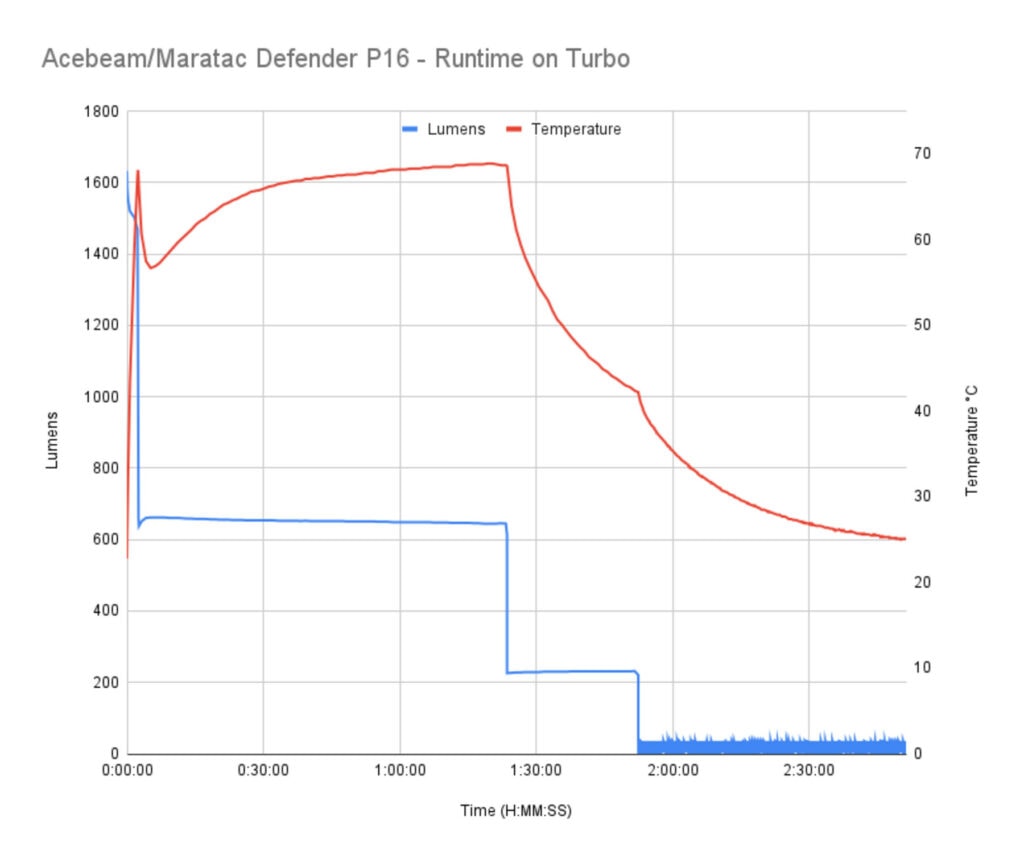
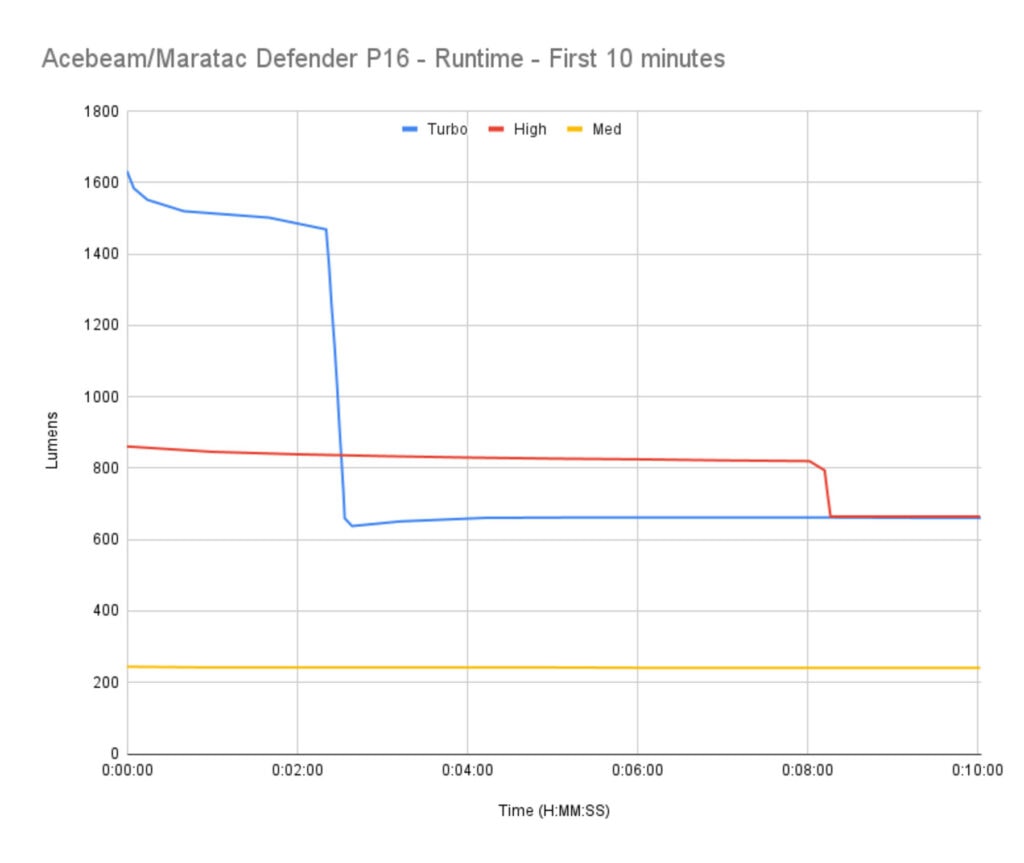
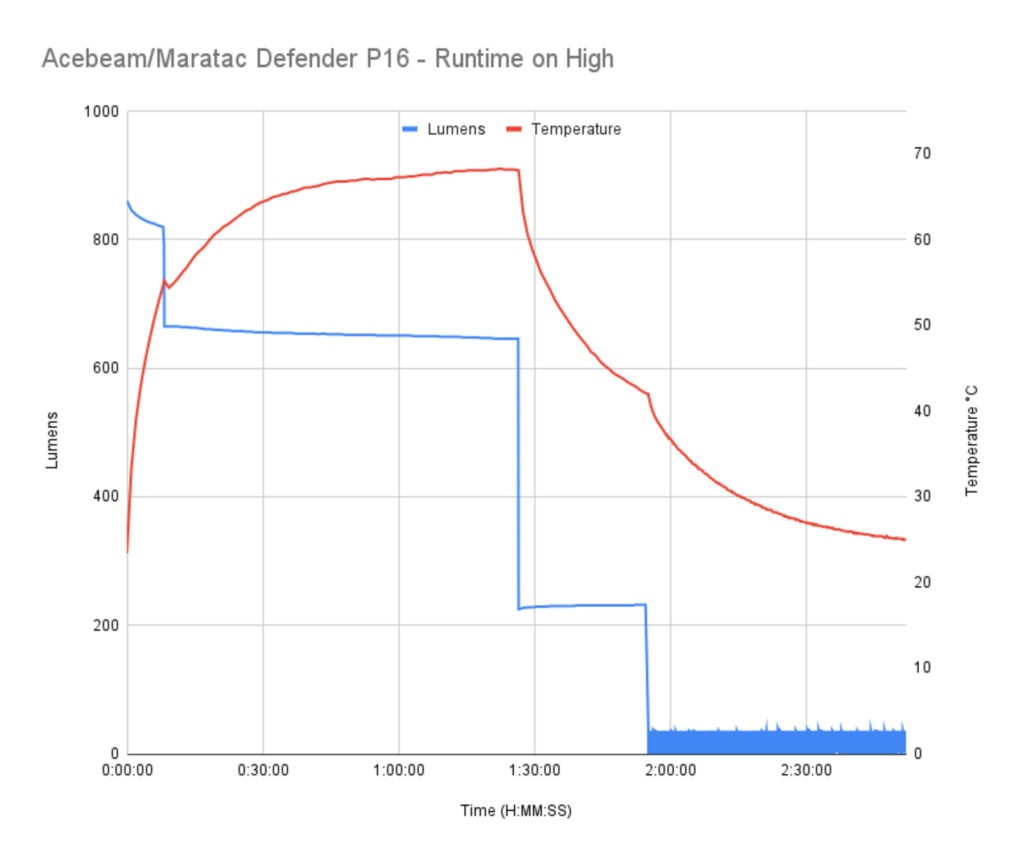
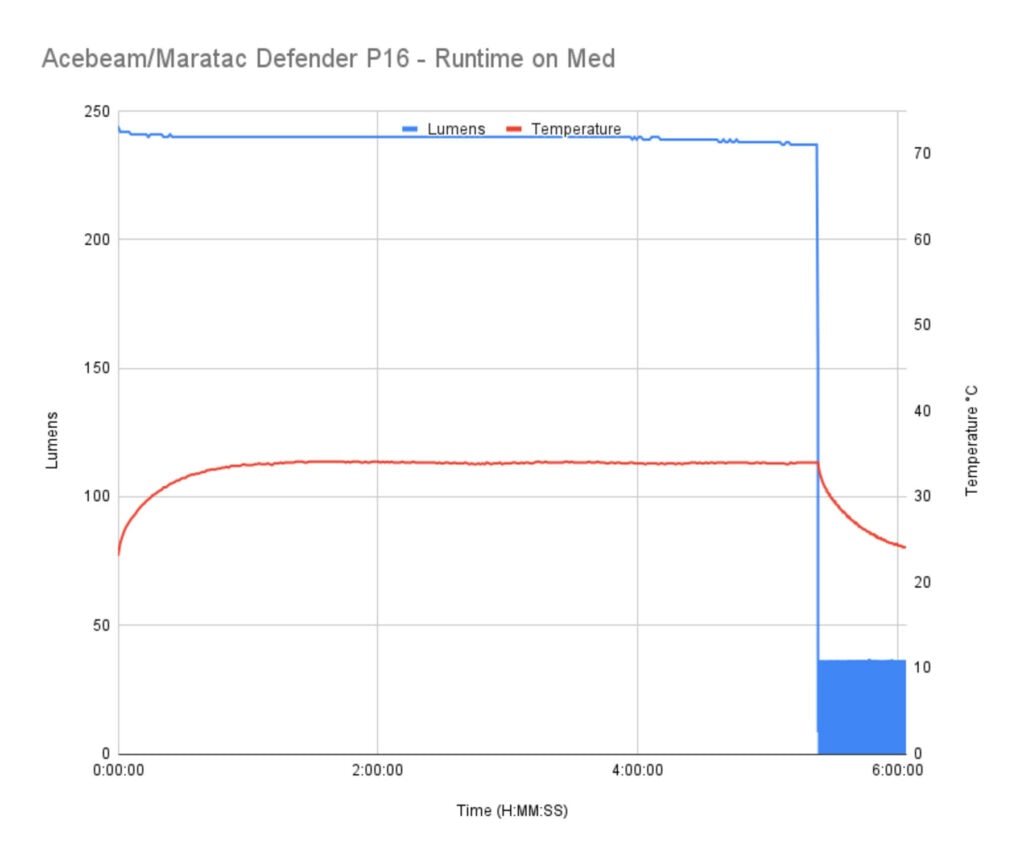
Peak beam intensity and beam distance measurements
About Peak beam intensity: Understanding ANSI FL1 Standards About peak beam intensity The calculated value of distance in meters at which the flashlight produces a light intensity of 0.25 lux. (0.25 lux is about the brightness of a full moon shining on an object). This means that the intensity has decreased so much, it becomes difficult to see darker objects, or objects that don’t reflect light. The columns ‘Meters’ and ‘Yards’ use rounded numbers.Throw was tested at 5 meters with my UNI-T UT383 BT
| Mode | Specs | Candela measured | Meters | Yards |
|---|---|---|---|---|
| Low | 2,756 cd | 1,300 | 72 m | 79 yd |
| Medium | 8,464 cd | 7,275 | 171 m | 187 yd |
| High | 25,760 cd | 25,550 | 320 m | 350 yd |
| Turbo | 58,564 cd | 46,950 | 433 m | 474 yd |
Nothing too surprising to see with the beam intensity results. They’re roughly in line with specs, but lower by a decent margin, just like the lumen output measurements. They’re not terribly far off, so battery strength could be a factor here.
Beamshots
Camera settings and distance:
Beam shots of the building are taken at 30 m (33 yd) using a Pixel 7 set to ISO 800 with 1/10 second exposure time
Beamshots of the following flashlights compared:
- Acebeam/Maratac Defender P16
- Olight Seeker 4 Mini
- Fenix E35R
Please note that beamshots are mainly intended to showcase the beam pattern and beam quality, rather than overall performance. These images are typically taken directly after activation, and do not fully represent its overall performance. For accurate performance metrics, such as output, beam distance, and runtimes, you need to look at the performance section of this review.


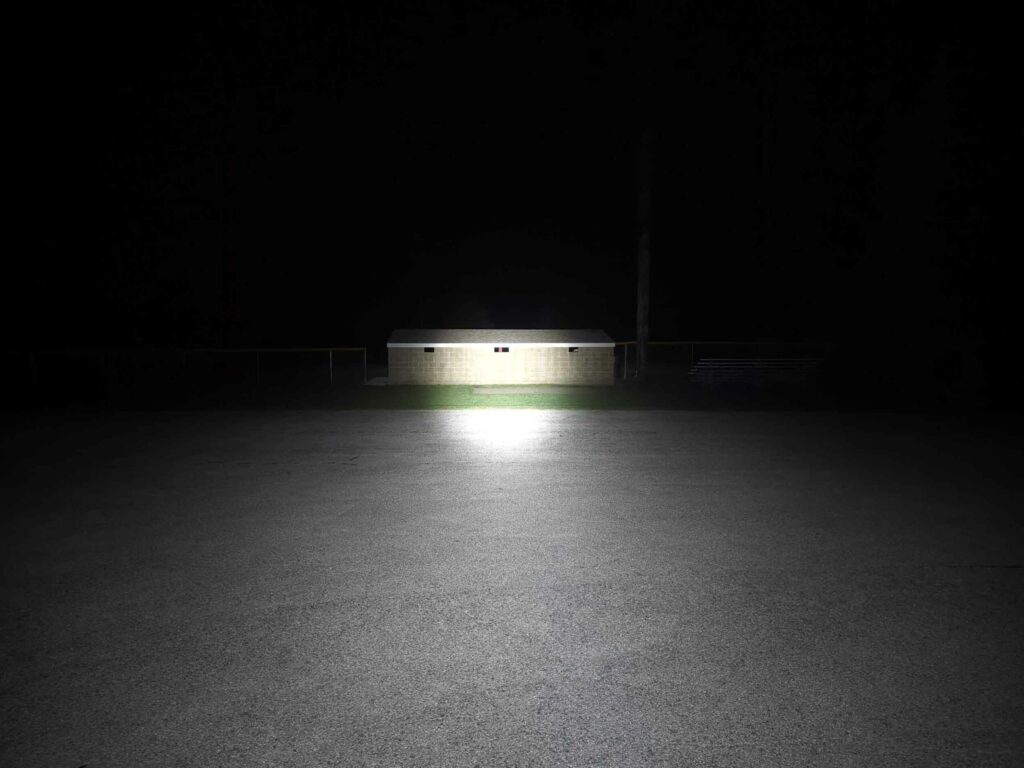
Disclaimer: This flashlight was sent to us for review at no cost by Maratac Defender P16. We have not been paid to review, nor have we been holding back on problems or defects.
Final Verdict
Pros
- Great build quality
- Well regulated output
- Relatively easy UI
- Two UI modes
- Unique OD Green Splash finish
Cons
- Missed lumen & intensity claims
- Tactical mode has memory instead of one-touch Turbo
- A lower low would be nice
Explanation on star ratings:
1: Avoid: a match would be a better choice – 2: Poor: significant defect or issues; almost unusable – 3: Average: some defects or issues; but still usable 4: Good: recommended (minor issues) – 5: Great: highly recommended

4 stars: ★★★★
While our star rating provides a reliable indicator, we encourage you to read the full review to make an informed decision based on your own needs and preferences.
There’s a lot to like about the special commemorative Acebeam/Maratac Defender P16. It’s a pretty cool tactical-ish (or EDC) flashlight, but not without its faults. First off, I measured lower output than what Maratac is claiming. That’s a bit sad. Second is that it seems like the P16 should have one-touch Turbo, likely from the Tactical Mode UI, but that feature is MIA (missing-in-action). There are a few other nice-to-have features that I would like to see (like a lower low and built-in charging), but those are my personal preferences. Those things aside, the compact high-quality build and unique finish are great benefits, the UI is pretty straightforward, and the custom TIR lens makes an excellent and clean throwy beam. Whether or not the Acebeam/Maratac Defender P16 is for you really depends on what you’re after in a flashlight – if you’re ok with the couple of “cons”, this would be a pretty sweet light.
Buy your Maratac Defender P16 here
1lumen selects and reviews products personally. We may earn affiliate commissions through our links, which help support our testing.